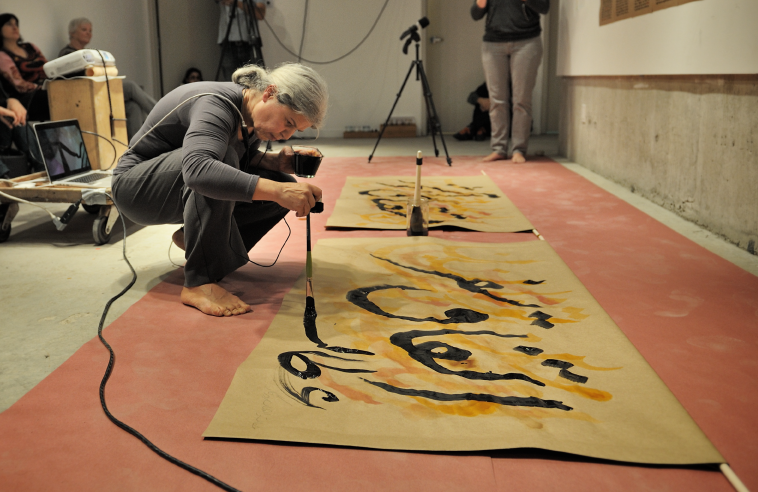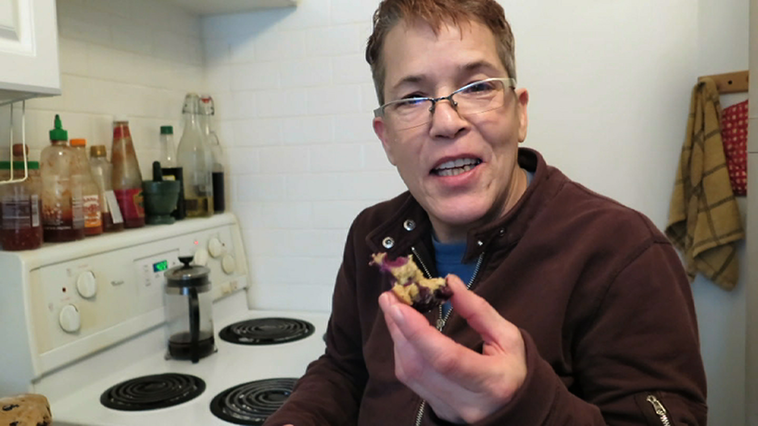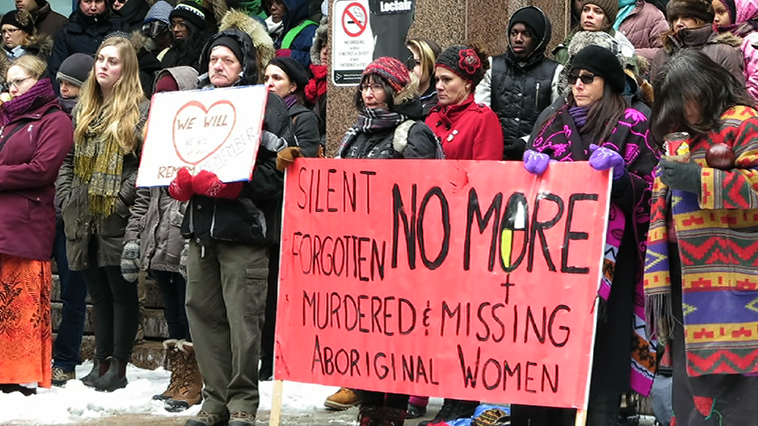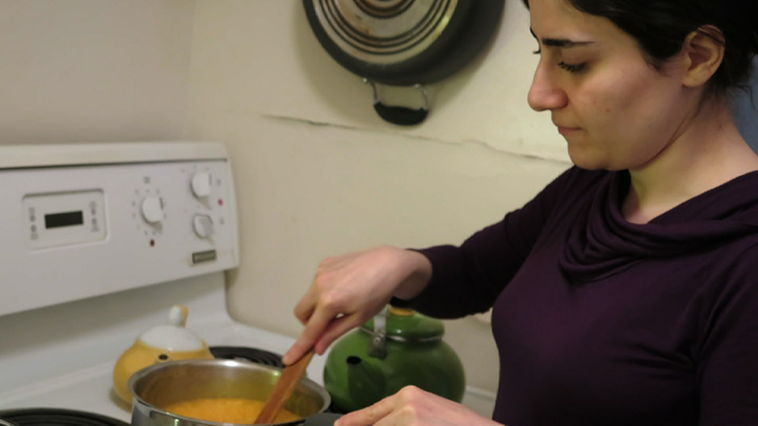
Gita Hashemi and Heather Hermant in Wonders of the Sea performance at Triangle Gallery, October 2014. Photo: Marc LeMyre
MUSKRAT Magazine’s contributing writer, Zainab Amadahy interviews the project’s creator, Gita Hashemi
Taking place on March 27, 2015, at Beit Zatoun in Toronto, Inhabiting the North is a dinner gathering, interactive performance and conversation open to women and trans women that brings together a number of collaborators from diverse treaty and Indigenous communities. Starting from the memoirs of a historical figure, Sayyida Salma (aka Emily Ruete, 1844-1924), the project aims to generate dialogue among the participants about gender-based issues related to Indigenous issues and migration, colonization and settlement, and East-West/South-North dichotomies.
The community feast is prepared by artists, activists and community groups from diverse backgrounds with the spirit of sharing the cultural significance of food, domestic space, and communal welfare. The feast is integrated with an interactive performance which involves three women, each Indigenous to a different land and carrying mixed heritage, engaging with Sayyida Salma’s critical views of her contemporary Europe through embodied reading and writing, discussion and dialogue with the audience.



Also integrated is a single channel projection including documentary videos of some of the food preparers demonstrating their process, and footage of the 2015 Toronto Strawberry Ceremony for Missing and Murdered Indigenous Women and Girls. This event will raise funds for It Starts with Us Project to support MMIW campaign. For more information, please visit http://passages.subversivepress.org
MM: Why did you decide to donate some of the proceeds from Passages II, Inhabiting the North to the missing women database project?
GH: The short answer might be that I believe we have to put our money where our mouth is. But let me elaborate a little. I have attended the Strawberry Ceremony for Missing and Murdered Indigenous Women almost every year since it started when there were barely 100 people, most of them Indigenous women and White allies with a few women of other racialized groups. I have seen it grow into a movement through the hard work of Indigenous activists and allies. This February we marked the 10th anniversary of the Strawberry Ceremony. It was the largest one. It brought out a lot of people of different Indigenous communities and many allies, women and men, and that was encouraging.

I noted, however, that there weren’t as many allies from other racialized communities as I had hoped to see. Their number hadn’t increased in proportion with the others. I was surprised because there was a huge surge during the Idle No More movement. So, I thought about why that was and what I could do to change it.
I’ve been an activist in the Palestine solidarity movement for a few decades. I have learned that as a solidarity activist the most effective work I do is in informing and mobilizing my own communities (Iranian and other communities that I belong to as an artist and activist) to support the Palestinian movement to defend themselves and their land against the Israeli state and settlers. Similarly, by raising funds through my project for It Starts with Us, I’m hoping to raise awareness about the struggles of the Indigenous peoples here.
More importantly, I’m signaling to my diverse communities that we must acknowledge our own status as settlers and treaty people and we must nurture relations of solidarity with the First Nations communities. In doing that, we must take our cue from Indigenous activists. They have identified MMIW project as a priority. What we can do in solidarity is to support that priority in whatever way that is possible for us. Ultimately this is a small gesture. Its value, more than the funds we raise, is in creating the space that we need to talk about these issues and to strengthen our relations of solidarity.
MM: Inhabiting the North is going to involve First Nations artists as creatives, readers and food providers. How do you imagine FN women might relate to Sayyida Salma’s story?
GH: I can’t speak for how FN women might relate to her story. I’m hoping to learn that through your involvement and the feedback I get from others. Although it is unique, Salma’s story carries many themes that can open the space for dialogue about gender-based issues related to world Indigenous issues and migration, colonialism and settlement, as well as East-West and North-South divisions that are rooted in colonial racial politics.
Sayyida Salma (1844-1924) is an interesting historical figure. Her mother was a Circassian woman who was orphaned as a young girl during an Ottoman war, brought to Zanzibar – a huge distance from her homeland – by a soldier and sold to the king of Oman and Zanzibar who eventually made her a secondary wife. Salma grew up in the court as an Arab “princess” (hence the term sayyida) with full equal rights to all the other children of the king.

When her father died, she was involved in supporting a brother’s claim to the throne against another brother. When her side lost, she moved to the city where she and her sister often received local luminaries and European expats. She developed a relationship with a German man, a merchant, and eloped when she became pregnant. She converted to Christianity and changed her name (to Emily) in order to marry her lover (so she took his last name and became Emily Ruete). Years later, living in Hamburg and raising three children, she decided to write her memoirs so that her children would know about their mother and her culture of origin.
I have selected and adapted passages from her memoirs where we can see the critical perspective that she brings to her new society in Europe. I took this angle because the “Western” myth is that the “Eastern” (Arab, Muslim, Middle Eastern, etc.) woman is in need of being rescued by the “Western” (White) do-gooders. The Palestinian scholar Edward Said calls such self-serving views about the “East” held by the White culture Orientalism. Orientalism is a cultural process by which the White hegemony makes the “East” (orient) inferior to itself. Orientalism is still dominant and was even stronger in Sayyida Salma’s time. Salma’s voice negates that Orientalist narrative. She was not a woman who needed rescuing. She left Zanzibar of her own volition, and she never really deserted her culture or bought into the idea that European “civilization” was superior to her own.
I think there are many aspects of her life, experience and views that many of us who are from different cultures might relate to as racialized women. In opening a space for conversation as part of the work, I’m hoping we will explore these issues together.
MM: You have plans to include clips from Toronto’s recent Feb. 14 Strawberry Ceremony. What do you see as the purpose/role of including these clips?
GH: Yes, I have asked the organizers for permission to project some clips from the footage that I shot on that day. I believe it’s important for me as an ally to be very respectful in handling this material so that I do not inadvertently appropriate and mis-represent the movement. I think showing some moments of that day would obviously be appropriate given that we’re raising funds for MMIW. But it’s more than that for me.

Our event is for women and trans women only. So clearly this is a prime space where we can think and talk about violence against women in general, and highlight the specific types of violence that Indigenous women face because they are Indigenous. There is also another reason.
I see many similarities between the Palestinian struggle and the struggle of Indigenous people on Turtle Island. That’s not surprising because in both cases the dynamic is that of an Indigenous people facing a settler-colonial state that has dispossessed them and rendered them invisible to a large settler population suffering from historical amnesia. (I should also point out that the women who will read Sayyida Salma in the event identify as Indigenous and Palestinian.) In bringing the voices from the Strawberry Ceremony to Beit Zatoun – which is a Palestinian cultural centre – I’m hoping to make that similarity more visible.
Lastly, showing this footage is my way of honouring the missing and murdered women, as a woman who is enraged at the hypocrisy of the settler state of Canada that justifies its participation in the wars in Afghanistan and Iraq partly by adopting that Orientalist narrative of saving Muslim women while it does so little to address systemic violence against Indigenous women here. In fact, the state itself is the original and biggest perpetrator of violence. I want all of my White and racialized friends and the audience to think about that hypocrisy and what they can do to expose it.
MM: What are some key ideas or realizations that you’d like the audience to take away with them?
GH: In my work, rather than prescribing any particular interpretation and ways of relating, I try to create spaces where we can collectively explore the intersections of our histories and cultures, differences and similarities in our experiences and visions. Ultimately, I see my work as a space for acknowledging and healing historical traumas and, through that, attending to the wellness of our present communities. Obviously this must be a collective undertaking. That is why I try to incorporate in my work meaningful processes of collaboration and engender creative forms of gathering and dialogue.
In Inhabiting the North, gathering over food is an integral process. I am hoping that as we warm up with the food that carries the flavours and histories of many cultures and peoples, and as we feel the bounty of the land and acknowledge the gracious labour of the providers, we can enter into a space where we see our inter-connectedness. In the Iranian culture – which is a mixed culture enriched by the cultures of the many peoples who have historically lived on the land – we believe that people who eat bread and salt together (which means share each other’s food) earn rights and responsibilities toward one another. This piece creates such an occasion.

I am glad for its timing too. Iranians celebrate the spring equinox as the beginning of the new year. We consider this time in the earth’s journey to be very special, so the first thirteen days of the year are given to family gatherings and communal feasts that include rituals of gratitude and prayers for a good year. It’s a good time to eat bread and salt together and to bring our hearts closer.
A free recording of this event will be made available online. For information when the recording becomes available like the event’s Facebook page or check in with the website.
Gita Hashemi’s transmedia practice focuses on historical and contemporary issues. In 2013, her solo exhibitions included Time Lapsed at A Space Gallery in Toronto and The Idea of Freedom at MAI (Montréal, arts interculturels), and she participated in The Third Space exhibition at Toronto’s Harbourfront Centre as part of Tirgan Festival of Iranian Art and Culture. Her most recent projects include Headquarters; Pathology of an Ouster, a multi-platform work including an installation, performance and webcast focused on the 1953 US-UK coup d’etat in Iran; Utopias In-Progress, a performance, video and installation about the effects of capitalism on the arts; Ephemeral Monument, an embodied writing performance, video and installation based on the literature of resistance in Iran between the coup and the 1979 Revolution; and The Book of Illuminations, a book/installation that draws on self-narrative and idiomatic Farsi to comment on repetitive political and cultural patterns. She is the initiating artist in Passages, a series of live art performances and video installations that use embodied writing and reading to explore 16th-19th century travel literature.









